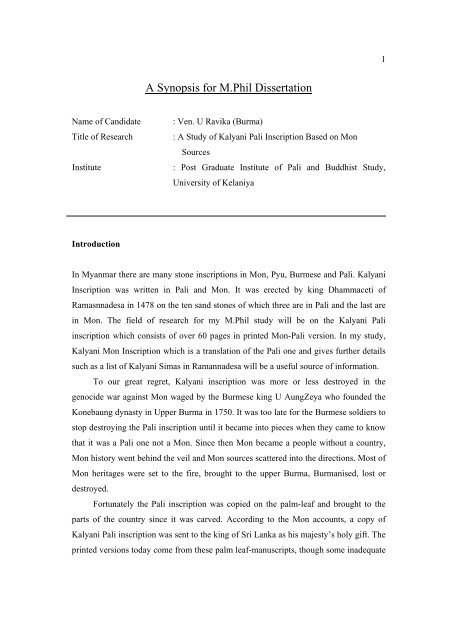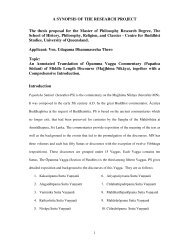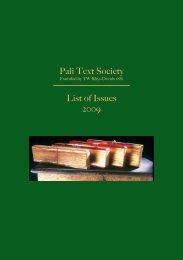A Synopsis for M.Phil Dissertation - Pali Text Society
A Synopsis for M.Phil Dissertation - Pali Text Society
A Synopsis for M.Phil Dissertation - Pali Text Society
You also want an ePaper? Increase the reach of your titles
YUMPU automatically turns print PDFs into web optimized ePapers that Google loves.
1<br />
A <strong>Synopsis</strong> <strong>for</strong> M.<strong>Phil</strong> <strong>Dissertation</strong><br />
Name of Candidate<br />
Title of Research<br />
Institute<br />
: Ven. U Ravika (Burma)<br />
: A Study of Kalyani <strong>Pali</strong> Inscription Based on Mon<br />
Sources<br />
: Post Graduate Institute of <strong>Pali</strong> and Buddhist Study,<br />
University of Kelaniya<br />
Introduction<br />
In Myanmar there are many stone inscriptions in Mon, Pyu, Burmese and <strong>Pali</strong>. Kalyani<br />
Inscription was written in <strong>Pali</strong> and Mon. It was erected by king Dhammaceti of<br />
Ramasnnadesa in 1478 on the ten sand stones of which three are in <strong>Pali</strong> and the last are<br />
in Mon. The field of research <strong>for</strong> my M.<strong>Phil</strong> study will be on the Kalyani <strong>Pali</strong><br />
inscription which consists of over 60 pages in printed Mon-<strong>Pali</strong> version. In my study,<br />
Kalyani Mon Inscription which is a translation of the <strong>Pali</strong> one and gives further details<br />
such as a list of Kalyani Simas in Ramannadesa will be a useful source of in<strong>for</strong>mation.<br />
To our great regret, Kalyani inscription was more or less destroyed in the<br />
genocide war against Mon waged by the Burmese king U AungZeya who founded the<br />
Konebaung dynasty in Upper Burma in 1750. It was too late <strong>for</strong> the Burmese soldiers to<br />
stop destroying the <strong>Pali</strong> inscription until it became into pieces when they came to know<br />
that it was a <strong>Pali</strong> one not a Mon. Since then Mon became a people without a country,<br />
Mon history went behind the veil and Mon sources scattered into the directions. Most of<br />
Mon heritages were set to the fire, brought to the upper Burma, Burmanised, lost or<br />
destroyed.<br />
Fortunately the <strong>Pali</strong> inscription was copied on the palm-leaf and brought to the<br />
parts of the country since it was carved. According to the Mon accounts, a copy of<br />
Kalyani <strong>Pali</strong> inscription was sent to the king of Sri Lanka as his majesty’s holy gift. The<br />
printed versions today come from these palm leaf-manuscripts, though some inadequate
2<br />
printings of it were published by the government of the Union of Myanmar as it is in<br />
damaged origin.<br />
The main purpose of this Kalyani inscription was to record the execution of king<br />
Dhammaceti’s sasana purification though it partly dealt with history of Buddhism in Sri<br />
Lanka, India and Myanmar. Some events in this inscription are obviously rather remote<br />
from the historical facts. However, it is a single historical <strong>Pali</strong> stone inscription both in<br />
Myanmar and Thailand.<br />
In Myanmar, drawing from the accounts of kalyani inscription, many books of<br />
chronicle were written. Among them the first Myanmar chronicle, Maharyazawingyi,<br />
by U Kalar is 233 years after the Kalyani inscription.The Sasanavamsadipani (The<br />
Book on the Lineage of Manastic Re<strong>for</strong>m of Buddhism) by the Paramasirivamsabhidhajamaharajaguru-mahathera<br />
of Toung-U is 312 years later and Sasanalankara-sartan, a<br />
famous book of Buddhist chronicle in Myanmar by a Burmese minister, Thirimahar<br />
nanda -Thingyan, is 350 years later.<br />
Turning to Thailand, there are two chronicles written in <strong>Pali</strong> after Kalyani<br />
inscription in which the event of Buddhism were presented almost similarly. These two<br />
books are the Cammadevivamsa (the History of Mon Queen Cammadevi of Haribhunjaya)<br />
written by Ven. Bodhiramsi and the Jinakalamalini (The Garland of Flowers in<br />
the Time of the Buddha) done by Ven. Ratanapanna.<br />
Over one and half centuries ago Kalyani <strong>Pali</strong> inscription was translated by many<br />
scholars into English, Burmese, Sinhalese, and Mon. Taw-Sein_Ko, a Burmese scholar,<br />
firstly translated the inscription into English and published it in 1892. At the beginning<br />
of the 20 th century, the Abbott of Bayarbyu Temple in Pazundaung, Yangon translated it<br />
into Burmese and following this, Ashin Kelasa of Pegu, in 1962, wrote a book in<br />
Myanmar_ the Kalyani Theintaw Thamaingsar (the History of Klayani Ordination Hall).<br />
Again in 1969, Ashin Acara of Kyaikkasan Monastery in Yangon, editing the <strong>Pali</strong> text<br />
and giving footnotes, reproduced a new Burmese translation. In Sri Lanka, as far as I<br />
am concerned, two books regarding the Kalyani inscription had been published: Kalyani<br />
Inscriptions, by Gintota, Medhankankara, Colombo, in 1924 and Kalyani Shilalipi, by<br />
Buddhadatta Thero, Polwatte, Colombo, in 1928 as well.
3<br />
The Mon translation of Kalyani <strong>Pali</strong> inscription was done by Bhaddantacariya<br />
<strong>Pali</strong>ta in 1967 and came to publication late in 1984. In contrast to the <strong>for</strong>mer pioneers,<br />
Bhaddantacariya tried to recover the underlying political and religious elements of the<br />
inscription which are more reliable than those of the Kalyani Mon Inscription published<br />
by the Burmese Research <strong>Society</strong> in 1958.<br />
The Scope of the Study<br />
As the Mon translation came late, I, a Buddhist monk of Mon, seem to be the latest one<br />
who wishes to do research on the Kalyani <strong>Pali</strong> inscription which was erected by a Mon<br />
king. The earliest candidate in this field is Patrick Arthur Pranke from the University of<br />
Michigan. In 2004, he submitted his dissertation in the title of “the Treatise on the<br />
Lineage of Elders (Vamsadipani: Monastic Re<strong>for</strong>m and Writing of Buddhist History in<br />
the 18 th century Burma). His work is identical to the Burmese historians by dealing with<br />
Kalyani inscription as a part of his research on Sasana-katikavata tradition.<br />
Next come Mr. Jason Carbine, from the United State too. Drawing from the<br />
Burmese commentary- Kalyani Theintaw Thamaingsar (the History of Kalyani Sima)<br />
and Taw-Sein-Ko’s English translation, he intends to reproduce a new English<br />
translation <strong>for</strong> publication in the Journal of the <strong>Pali</strong> <strong>Text</strong> <strong>Society</strong>. In his message sent to<br />
me, I was told that he will add to his work a study of socio-historical and cultural<br />
significance of Kalyani sima which is a material one.<br />
There is still growing interest in Kalyani <strong>Pali</strong> inscription. Venerable Abhayatissa,<br />
a pandit of Sri Lanka and a lecturer of Buddhist and <strong>Pali</strong> University of Sri Lanka, is<br />
doing the same research as well basing on Kalyani <strong>Pali</strong> inscription and Taw-Sein-Ko’s<br />
English translation. According to him, the work is in eight months progress at the<br />
University of Kelaniya.<br />
There is not much work completely done on this inscription. The <strong>for</strong>mer<br />
candidates have failed to use Mon sources. The study points based on Mon sources are<br />
still left untouched and some Burmese and Thai sources still wide-open. There<strong>for</strong>e, my
4<br />
study is generally proposed to appear with Mon sources since the Kalyani <strong>Pali</strong><br />
inscription is still needed to be approached in the different sources and methods of study.<br />
The Methodology of the Study<br />
At first, I will classify the contents of the inscription. In original <strong>Pali</strong> text there is no<br />
table of contents classified and it goes through the process of the events. I find a book of<br />
Kalyani Mon translation written by Bhaddantacariya <strong>Pali</strong>ta which can be used as my<br />
basic and principal source to create a table of contents. Bhaddantacariya, the author of<br />
this book, has divided the <strong>Pali</strong> texts into thirty episodes with an introduction which are<br />
given as a table of contents. In my study these contents will be divided into four<br />
categories as to classification.<br />
Secondly the extended study of historical and cultural significances of the<br />
inscription will be followed. For historical and social study I will depend on Mon<br />
sources as my primary elements and Burmese, Thai and English sources as secondary.<br />
This point of study may be the same as the others but the sources used are vividly<br />
different.<br />
When I study the history of Buddhism in India, Sri Lanka, and Ramannadesa, I<br />
will discuss the historical legends with an air of myths which I dislike. To do this<br />
research the first series I would depend is Slapot Rajavam Datoh Smim, the Royal<br />
Chronicles, which was translated into German and published by FR. Schmidt in 1906<br />
and republished in a new edition in 1923. The second, known as Paklat Chronicles, is a<br />
collection of historical texts written by anonymous in ancient times published in 1910<br />
and 1912 in two volumes at Paklat near Bangkok, Thailand. These volumes have never<br />
been translated or studied except <strong>for</strong> a few excerpts from the second part. My study will<br />
deal with the second one which is fully related to king Dhammaceti. The third and the<br />
last series, Vam Dun Suvannabhumi, The History of Suvannabhumi Kingdom, is a<br />
printed text book by the OTMLTBC (The Organization <strong>for</strong> teaching Mon Language and<br />
Training Buddhist Culture).<br />
After the critical study of history, I will continue my work with the study of social<br />
or cultural grounds. In this study I will, with a critical point of view, present the
5<br />
foundation and architecture of the Kalyani Sima which was built according to the Mon<br />
ritual system and Buddhist vinaya rules. For the ritual or social study, two books,<br />
Vinayamahavagga <strong>Pali</strong> and Prakoh Lokasiddhi, are indispensable. Prakoh Lokasiddhi is<br />
a book of tantra-mantras showing the way how to manage a good life. Even though it<br />
has not been translated into other languages yet, it is very popular among Mon and it is<br />
taught to the monastic students at the Mon Buddhist monasteries in Mon State until the<br />
present days.<br />
At last, I will identify the name of the places found in the inscription. Identifying<br />
the name of the places is also essential in my study. Basing on the old Mon and <strong>Pali</strong><br />
inscriptions discovered in Burma, Thailand, Loa PDR and The Royal Kingdom of<br />
Cambodia, I will go into details about the historical sites such as Suvannabhumi,<br />
Ramannadesa, Pugama and so on which are very critical among the scholars. In this<br />
stage I will make surprise by linking some epigraphs, <strong>for</strong> example, the triple word Michen<br />
or Pi-chen(Chinese), Besinga(Greece) and Vesunga(<strong>Pali</strong>) which refer to the Mon<br />
word ‘Bi-cing’, the name of the capital of Suvannabhumi from the 3 rd century BC to the<br />
9 th century AD. Further more, Ramannadesa in my study will mean more than what the<br />
present scholars have reached.<br />
In addition, the translation study of Kalyani <strong>Pali</strong> inscription will be postponed at<br />
the time being. I will keep continuous watch on the proceeding of other candidates<br />
while my research is being conducted. For example, in the Kalyani <strong>Pali</strong> inscription on<br />
the page 50 lines 8&9 (according to the Mon version), There are two <strong>Pali</strong> phrases:<br />
Varacakka sankhittaya and Sattarajasenayabbhibhutatta. In his translation Taw-Sein-Ko<br />
took “the excellent religion” as the meaning of “varacakka” and “seven kings” as<br />
sattaraja. I am concerned about this translation thinking if varacakka means ruling and<br />
sattaraja (perhaps satturaja) the enemy king. It may have a problem to basically consult<br />
this matter because in Sinhalese version is shown ‘thiracakka’ and in Kalyani Mon<br />
stone inscription is missing this part. In fine if ‘the excellent religion’ is taken, then the<br />
connection of ‘varacakkasankhittaya’ with ‘sattarajasenayabhibhutatta’ is unlikely to be<br />
suitable. If the ‘seven kings’ are taken as sattaraja, then the names of them should be<br />
presented definitely. Mr. Jason Carbine and Ven. Abbhayatissa, I believe, will notice
6<br />
such a critical point. There<strong>for</strong>e, I will as of now do my study of Kalyani <strong>Pali</strong> inscription<br />
and will reproduce a new English translation only if necessary.<br />
In my work the potential contents are as follows.<br />
1. Introduction<br />
2. Historical background of King Dhammaceti<br />
3. Historical background of Kalyani Sima with a list of historical sites.<br />
4. Study of thirty classified contents of Mon translation<br />
5. Study of the inscription in four categories<br />
6. Study of history of Buddhism in India, Sri Lanka, Ramannadesa or<br />
Suvannabhumi ( the Mainland of SEA) found in the Kalyani <strong>Pali</strong> inscription<br />
7. Study of history of Buddhist order-sects found in the Kalyani <strong>Pali</strong> inscription<br />
8. Study of travel and diplomacy from the Kalyani <strong>Pali</strong> inscription<br />
9. Study of Sima, ordination hall and Upasampada, Buddhist monk ordination<br />
recorded in the Kalyani <strong>Pali</strong> inscription<br />
10. Study of the name of places from the Kalyani <strong>Pali</strong> inscription<br />
11. Conclusion<br />
12. Bibliography, Appendix and index<br />
If a new English translation is in necessary, the above study will be moved to the<br />
footnote of the translation.<br />
Primary Sources<br />
1. Trai Loik Tmoh Kalyani, <strong>Pali</strong>ta Bhaddantacariya, Daw Sein Nwe Press,<br />
Rangoon, Burma, 1984 (<strong>Pali</strong> & Mon Version)<br />
2. The Mons: A Civilization of South-east Asia, Guilon Emmanuel, The Siam<br />
<strong>Society</strong>, Bangkok, Thailand, 1999<br />
3. Kalyani <strong>Pali</strong> Inscription, Original <strong>Text</strong>, Burmese Research <strong>Society</strong>, Rangoon,<br />
Burma<br />
4. Kalyani Mon Inscription, LuPeWin Thiripyanchi U, Ministry of Culture,<br />
Burma, 1958 (Mon Version)
7<br />
5. The Collection of Mon Article, The Journal of Burma Research <strong>Society</strong>,<br />
Rangoon, Burma<br />
6. Slapot Rajavam Datoh Smim, History of the Kings, National Library of<br />
Rangoon,1843 (manuscript)<br />
7. Prakoh Lokasiddhi, The treatise on the Formation of the Universe,<br />
Samachanda Press, Moulmein<br />
8. Uppannasudhammavatirajavamsakatha & Uppannahamsavatirajavamsakatha,<br />
by the anonymous, Paklat, Bangkok, Thailand, 1909&1910 ( Old Mon<br />
Version)<br />
9. Mahavaggapali ( Vinayapitika), Chattasangayana Edition (BCE), 1991<br />
10. Mahavaggatthakatha (Vinayapitaka) Buddhaghosa Bhaddantacariya, BCE,<br />
1986<br />
11. Vinayasangahathakatha, Sariputtathera, BCE, 1970<br />
12. Kankhavitarani Atthakatha, Buddhaghosa Bhaddantacariya, BCE, 1990<br />
13. Vinayalankaratika, Vol.1, Tipitakalankara, Kenacithera, BCE, 1962<br />
14. Simavisodhanipatha, Sagarabuddhi, BCE, 1984<br />
15. Vimativinodanitika, Vol.II, Coliyakassapathera, BCE,m 1960<br />
16. Vajirabuddhitika, Vol.II, Varirabuddhithera, BCE, 1960<br />
17. Saratthadipanitika, Vol.III, Sariputtathera, BCE, 1981<br />
Secondary Sources<br />
1. The Culture of Southeast Asia, Le May Reginald, Unwin Brother Limited,<br />
Great Britain<br />
2. The Teaching of The Buddha (Higher Level) Volume II, DPPS, Rangoon,<br />
Burma, 2001<br />
3. The History of Buddhism in The Suvannabhumi Period (Burmese Version), A<br />
M.A Thesis Submitted to the SPS University, Yangon, Myanmar, 2003<br />
4. Dhammaceti Mahakalyani Kyauksar, Acara Kyaikkasan U, PyiKyiMandaing<br />
Press, Rangoon, 1969 (<strong>Pali</strong> & Burmese Version)<br />
5. Rajavam Akrom Dhammaceti, The Struggle of King Dhammaceti, National<br />
Library of Rangoon, 1793 (manuscript)
8<br />
6. Rajavam Smoin Dhammaceti, History of King Dhammaceti, National Library<br />
of Rangoon ( manuscript)<br />
7. Vam Timlak Smoin Dhammaceti, History of the Simas During the King of<br />
Dhammaceti, National Library of Rangoon( manuscript)<br />
8. Rajavam Ava Hamsavati, History of Ava(Capital of Upper Burma) and<br />
Hamsavati( Capital of Lower Burma), National Library of<br />
Rangoon,1766( manuscript)<br />
9. Rajavam Sadhom Kov Hamsavati (pathama), History of Suvannabhumi and<br />
Hamsavati, National Library of Rangoon( manuscript)<br />
10. Rajavam Sadhom Kov Hamsavati (dutiya), History of Suvannabhumi and<br />
Hamsavati, National Library of Rangoon( manuscript)<br />
11. Dhatuvam Bvai Kamnon, Short History of the Relics, National Library of<br />
Rangooon( manuscript)<br />
12. Over one hundred relevant sources are under my studying and will be<br />
presented later.









